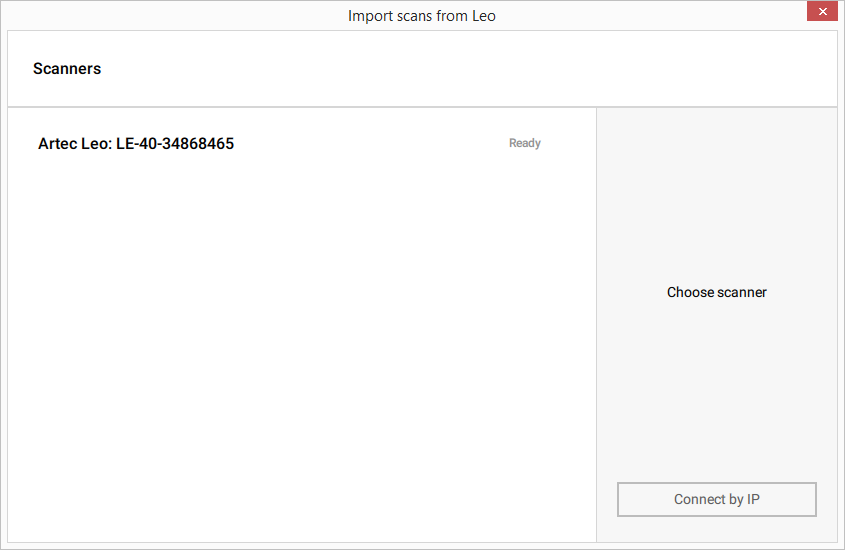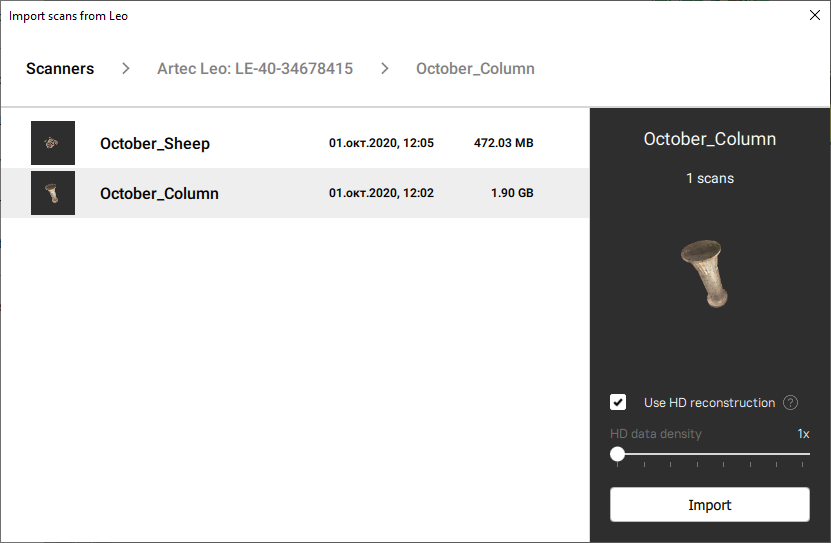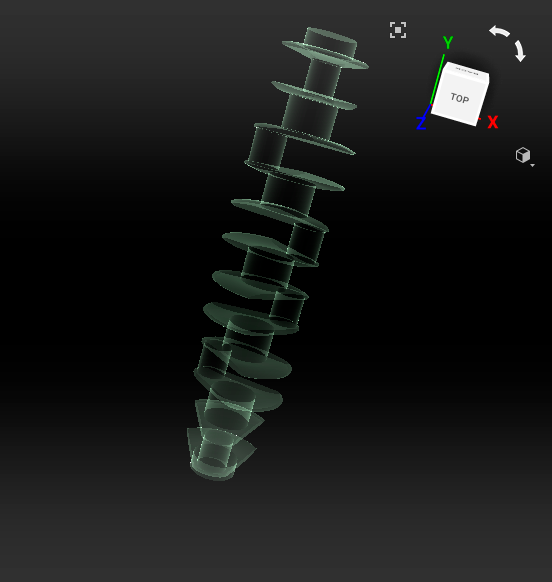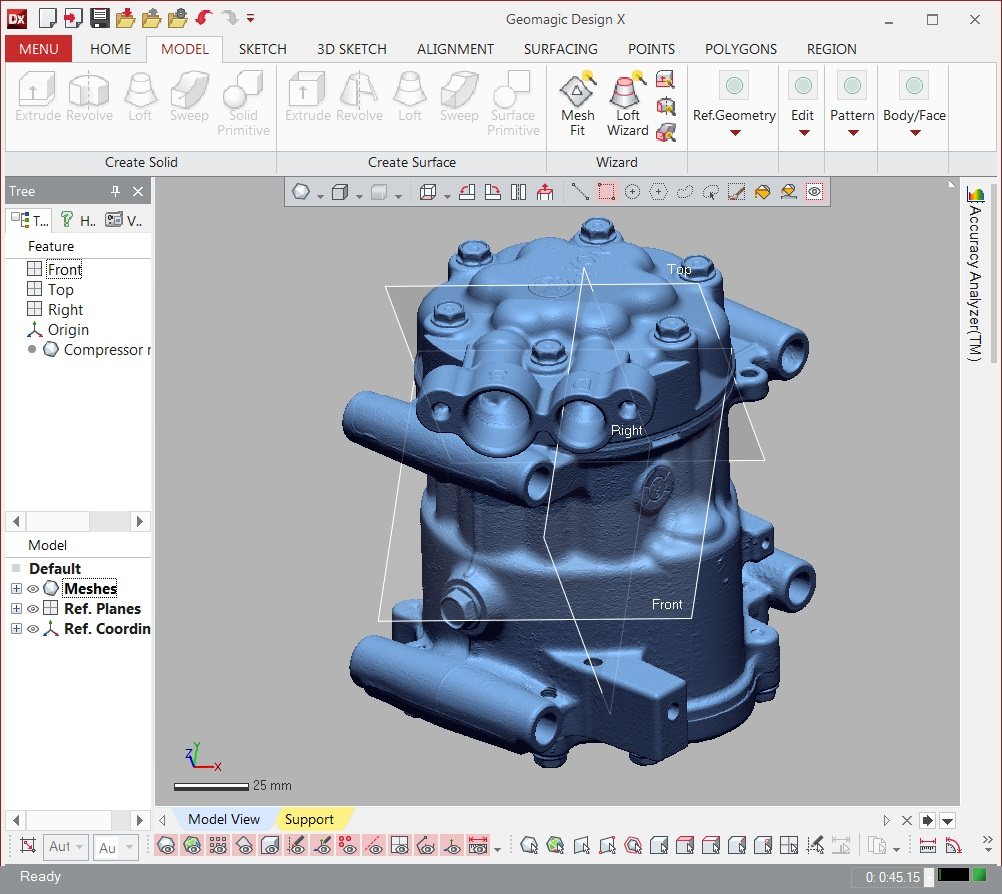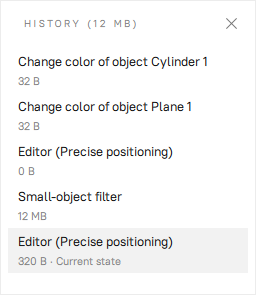Projects, Scans and Models¶
A project encompasses all 3D data obtained by scanning and postprocessing that can be saved to disk and accessed for later use. In addition, it contains command history and measurement results. For each project, a corresponding folder contains all project data as well as a project file describing the structure of that data.
Artec Studio can display project statistics. It includes information on number of scans, surfaces (frames), polygons, vertices and UV coordinates.
To access this data, call a right-click menu for any Workspace object and select Project info.
If you want to collate data on the selected scans with the total numbers for the project, first mark the required scans using with the  flag.
flag.
Creating a Project¶
To start a new project, select the File → New project menu option. It is a best practice to save this project to a specific folder before you start scanning. If you start scanning with the Save scans directly to disk option enabled or import scans from Ray, a temporary project is created in the Windows temporary folder or another directory if you specified one in Settings.
Saving a Project¶
You can save your project using the File → Save project menu option or by hitting Ctrl + S.
While you’re working with a saved project, the header of the application window displays its full path. Save your project from time to time in the course of processing or otherwise using the scanned material.
Note
Artec Studio saves data incrementally, meaning that if you save an existing project, the application will only save newly changed or added data.
Opening Project and Scans¶
To open an existing project, use the File → Open project menu option or hit Ctrl + O.
Note
Files from Artec Studio versions 8, 9, 10 and 11 are mutually compatible. Earlier versions, however, may be unable to open projects saved in a later version using the SPROJ format.
By default, when you open a project, the application will restore it to the state in which it was last saved (the three scan-loading states include loaded, unloaded and key frames only—see Memory Management: Object Unload). To load faster by opening the project without loading any scans, use the Open project (unloaded scans)… option from the File menu or hit Ctrl + Shift + O.
Note
When Artec Studio opens a project, it will determine the amount of available memory. If the scan you are trying to load requires more memory than is available in your system, the application will process it as an “unloaded” scan.
Opening a Project from Leo¶
You can obtain projects from Leo via direct connection to the scanner or using an SD card installed in the device.
Connecting to Leo¶
Ensure that your Leo scanner and your computer are connected to the same network and you authenticated using the same credentials
Click File → Import → Leo project (connect to scanner)
Wait for the application to show your Leo scanner. If no device is displayed or you are using a direct connection, follow the steps indented below:
- Click Connect by IP
- Specify IP address that you may find in Leo network settings
- Click Add
Select the required scanner and click Connect
Then using either LMB or ↑ and ↓ select the project that you want to load (Figure 76)
If the selected project contains HD data and you want to upload it, perform the following actions:
- Check Use HD reconstruction.
- Select the desired HD data density in the range from 1× to 64× using the eponymous slider.
The HD data density determines the number of polygons per frame that is used for reconstructing the scanned surfaces from the raw data. With 1× the number of polygons is of the same order as for the SD resolution and 64× corresponds to ~5 million polygons per frame. Increasing the HD data density results in higher degree of resolution, coverage, and detail, but requires more memory and time for the HD reconstruction.
Important
If Artec Studio evaluates your computer’s resources as insufficient for the selected HD data density, then the warning is displayed that the HD reconstruction can take up to several hours on your computer. For information on resources requirements, see the Using HD mode section in System Requirements.
Click Import.
If you have enabled the HD reconstruction, it will start immediately after the data uploading finishes.
Wait for scans to appear in the Workspace panel.
The imported project and scans will be automatically grouped—the group with the project name will be divided into subgroups of scans (see here about grouping). The imported HD scans will have an “HD” mark in their names, for example: Leo HD Scan 1.
If the scans contain information on supporting surface and the corresponding option is enabled in Settings, Artec Studio will also launch base removal.
Note
You can import HD projects from Artec Leo multiple times with different values of HD data density.
Using SD Card¶
If you want to open Leo scans without having to connect to the device, use the following method:
- On Leo, first copy a project to SD card.
- Then insert the card into the computer with installed Artec Studio.
- Click File → Import → Leo project
- Browse for the required project folder
- Select the folder containing Leo project and click Select folder. Import will start.
Note
HD data is not stored in the projects exported to an SD card.
Importing Models and Scans¶
Importing is another way to load data into Artec Studio in place of capturing or opening a project. You can import scan files created in earlier versions of the software, individual frames, point cloud data, as well as CAD models in the following formats:
SCAN |
Artec 3D scan format |
PLY |
Stanford polygon file format |
STL |
Stereolithography file format |
VRML |
VRML file; actual extension is *.wrl |
OBJ |
Wavefront OBJ file format |
PTX |
Disney per-face texture mapping format |
C3D |
Artec Ray original point cloud |
BTX |
Artec Ray point cloud |
STEP, STP |
(CAD format) Standard for the Exchange of Product model data |
IGES, IGS |
(CAD format) Initial Graphics Exchange Specification |
X_T |
(CAD format) Parasolid XT data format |
Importing Scans, Meshes or Point Clouds¶
To import a file, use the File → Import → Scans, meshes or point clouds menu option or hit Ctrl + I . Next, select a file for importing. You can also drag and drop a file into the main Artec Studio window, or just double click on it.
Note
The import process runs in the background, so you can continue working with the scans you’ve already loaded. The progress indicator for the import operation will appear at the bottom of the main application window. To abort the operation, click Cancel in the bottom-right corner.
Artec Studio will import frame files as individual single-frame scans. After importing each scan, the application calculates the key frames for any scan that contains more than one surface. Also, the application will check the surfaces for defects when the appropriate setting is enabled (see Surface-Consistency Detection During Import). If it finds defects, it will show a dialog with a list of defective surfaces once the import operation is complete. You can then choose which ones should be corrected.
Importing CAD models¶
You can import CAD models created in different CAD programs and saved to the following formats: STEP, STP, IGES, IGS, X_T.
To import a file, use the File → Import → CAD models menu option. Next, select a file for importing. You can also drag and drop a file into the main Artec Studio window, or just double click on it.
Exporting Models, Scans and Point Clouds¶
When you want to store data for future processing, the best approach is to save the project as an SPROJ file or to export the data to the SCAN format. Any Artec Studio version can open the latter format. If you plan to use the data in other applications, however, you should save scans and individual frames in another format.
You may also need to perform one of the following tasks:
Exporting Scans¶
To export scans:
- Mark any scans you want to export using the
 button.
button. - Select the File → Export → Scans command.
- Click the … button to open and specify the destination folder.
- Select Scan export format using the eponymous dropdown list.
- If the selected format supports textures, also specify the texture format.
- Select the Apply transformation checkbox, or leave it cleared (for more information, consult Understanding How Artec Studio Applies Transformations).
- Click OK.
ply |
Stanford polygon file format |
stl |
Stereolithography file format |
obj |
Wavefront OBJ file format |
wrl |
VRML file; actual extension is *.wrl |
x |
Direct X file format |
scan |
Artec 3D scan format |
plyVC |
Stanford polygon file format with vertex colors, actual extension is *.ply |
obc |
OBC point-cloud file |
Note
The export process for models and scans runs in the background, so the application will allow you to continue working with the scans. The progress indicator for the export operation will appear at the bottom of the main application window. To abort the operation, click Cancel in the bottom-right corner.
Exporting Meshes (Models)¶
To export a mesh:
Mark one or more models using
 or select frames in the scan by clicking on them while holding the Ctrl key.
or select frames in the scan by clicking on them while holding the Ctrl key.Select the File → Export → Meshes command.
Tip
Ctrl+Shift+E hot key does the same.
Specify the destination folder, enter the file name, and select the appropriate mesh format from the dropdown list [1].
Click Save.
If the model has texture and the format supports it, specify the Texture export format in the new dialog (see Storing and Exporting Color Information).
Click Export.
PLY |
Stanford polygon file format (standard and with the support for vertex color) |
STL |
Stereolithography file format |
VRML |
VRML file (1.0 and 2.0); actual extension is *.wrl |
OBJ |
Wavefront OBJ file format |
ASC |
Point cloud 3D format |
AOP |
American Academy of Orthotists and Prosthetists file format |
PTX |
Walt Disney Ptex: mesh with per-face texture mapping |
X |
Direct X file format (binary and text) |
XYZRGB |
XYZRGB file format |
E57 |
ASTM E57 3D file format |
| [1] | If you type an extension in the file name field, application will use it rather than the selected mesh file format. |
See also
Exporting CAD objects¶
You can export CAD primitives created in Artec Studio to the following formats: STEP, IGES, X_T.
To export CAD primitives:
Exporting Point Clouds¶
You can export point-cloud scans obtained from Ray scanner to either of the following formats (respective units are given in the third column):
PTX |
Leica Geosystems Cyclone Point Cloud. Important! Don’t confuse it with Disney Ptex. |
Meter |
XYZ |
XYZRGB file format | Specified in settings |
BTX |
Artec Ray point cloud; various versions (v2, v3, v5, v6). | Micron |
- Mark one or more point-cloud scans using
 flag in Workspace. Ensure that you have selected a point-cloud scan by double-clicking its name: the panel must show point-cloud properties.
flag in Workspace. Ensure that you have selected a point-cloud scan by double-clicking its name: the panel must show point-cloud properties. - Select File → Export → Point clouds.
- Specify the destination folder and required format and click Save.
Merging Sections¶
When exporting to PTX, ensure the Export point clouds to PTX with merged sections checkbox is marked in the Artec Studio settings. This option merges all sections (selections made during scan with Ray scanner) so that third-party software products can open the exported file.
Understanding How Artec Studio Applies Transformations¶
Artec Studio offers two options for exporting surfaces:
- Store surfaces using the scanner coordinates and create
XFtext files that contain the coordinates calculated during registration. To use this approach, clear the Apply transformations checkbox. - Store surfaces that are relocated to the positions calculated during registration. In this case,
XFfiles contain no relevant data. To use this approach, select the Apply transformations checkbox.
Special Aspects of Scan Placement¶
In most cases when you’re exporting a scan to a common 3D-graphics format, you should select the Apply transformations checkbox. By doing so, you instruct third-party applications to display surfaces in the same way that Artec Studio does: that is, with the origin at the center of mass. If for some reason you need to store a scan in the scanner’s coordinate system—in other words, with surfaces located at a distance from the origin that is equal to scanner’s operating range—clear the Apply transformations checkbox.
Technically, Artec Studio saves scans in the scanner’s coordinate system, but it displays them in a user-friendly manner by placing the origin at the center of mass. The actual positions of surfaces calculated during registration are stored in text (XF) files. Therefore, when you’re importing files using Artec Studio, it makes no difference whether the checkbox was cleared when Artec Studio exported them. It does make a difference, however, for third-party applications that cannot read XF files simultaneously with 3D geometry.
Storing and Exporting Color Information¶
You can transfer color information for 3D surfaces in three ways. The most common is through a texture using a separate bitmap file (see Applying Texture (Procedure)). Another option is to save color information in each vertex of a mesh. The third is to assign a small textured fragment to each polygon. The two latter methods produce no texture files.
Colors stored in a vertex are blended throughout the polygon. As a result, you should avoid oversimplifying the exported mesh; otherwise, colors blended over a large face may fail to render true texture information.
| Texture stored as a bitmap | PLY, VRML (*.wrl), OBJ, X, e57 |
|---|---|
| Model file contains separate texture for each face | PTX |
| Formats that support vertex color | plyVC, XYZRGB |
When exporting texture as a bitmap image, you can select one of the following formats: PNG, BMP or JPG. PNG format provides the best quality for a given file size thanks to its lossless image compression. JPG is the most compact format.
Exporting Target Coordinates¶
If you scan while in the Targets tracking mode using only Artec scanners, you can save an OBC file containing the target coordinates. Once you finish scanning, run Global registration, then do the following:
- Use the
 button to mark any scans that you captured without having uploaded an
button to mark any scans that you captured without having uploaded an OBCfile. - Select the File → Export → Scans command.
- Click the … button to open and specify the destination folder.
- Select obc from the Scan export format dropdown list.
- Click OK. The
targets.obcfile will appear in the folder you specified.
For more information on the OBC file structure, consult the FAQ.
Exporting to Leios¶
Artec Studio enables you to export files to Leios by accessing the File menu if the Leios software is already installed on your computer.
- Select a model in the Workspace panel
- Open File → Export to Leios
- Then, in Leios, select millimeters as the length unit for the imported files.
Exporting to Geomagic Design X¶
Polygonal models created in Artec Studio are insufficient for most design needs. Geomagic Design X (formerly Rapidform XOR) is purpose built to create manufacturing-ready CAD models directly from meshes.
To export a model,
Exporting to SolidWorks¶
Artec Studio allows you to export models to SolidWorks by using third-party plug-ins. It supports the following plug-ins:
- Geomagic for SolidWorks
- DezignWorks for SolidWorks
To export a model,
History of Project Changes¶
Artec Studio stores all data changes, and you can later undo any unnecessary changes.
You can see the saved changes and their use of memory in the History panel.
To open the panel, click the  button at the bottom left or hit Ctrl+H
button at the bottom left or hit Ctrl+H
Click on the desired operations in the list to undo or redo them. Operations can be undone (redone) only sequentially, i.e. you cannot skip any of them selectively.
To quickly undo or redo the changes stored in the project history, you can also use the following options:
- Undo:
- Redo:
When you save a project, Artec Studio stores 3D data together with the history of changes. You can select the maximum length of the history in the settings window under the Performance tab (see Command History). In addition, the Compact memory button allows you to save the history of changes on a local drive and thus free up RAM. Also, the Clear command history button clears the change history, likewise freeing up RAM, and makes the undo operation for the most recent changes unavailable. To clear the history, you can use the Edit → Clear history menu option in the main window or hit Ctrl+Alt+H.
See also
Command History in the Settings section.
Autosaving a Project¶
A project can be saved by either the user or Artec Studio. The latter case is called autosaving. For temporary (i.e., unsaved) projects, autosaving is unavailable. The application autosaves a project in the following cases:
Before running the texturing algorithm (see Texturing)
When scanning is complete and the Save scans directly to disk option is selected (see Scanning Procedure)
When unloading scans with unsaved changes (see Memory Management: Object Unload)
When the Save project before starting algorithms setting is selected (see Autosave Options):
- Before launching algorithms from the Tools panel
- Before and after running the Global registration algorithm (Global Registration)
- Before starting Autopilot (Use Autopilot).
